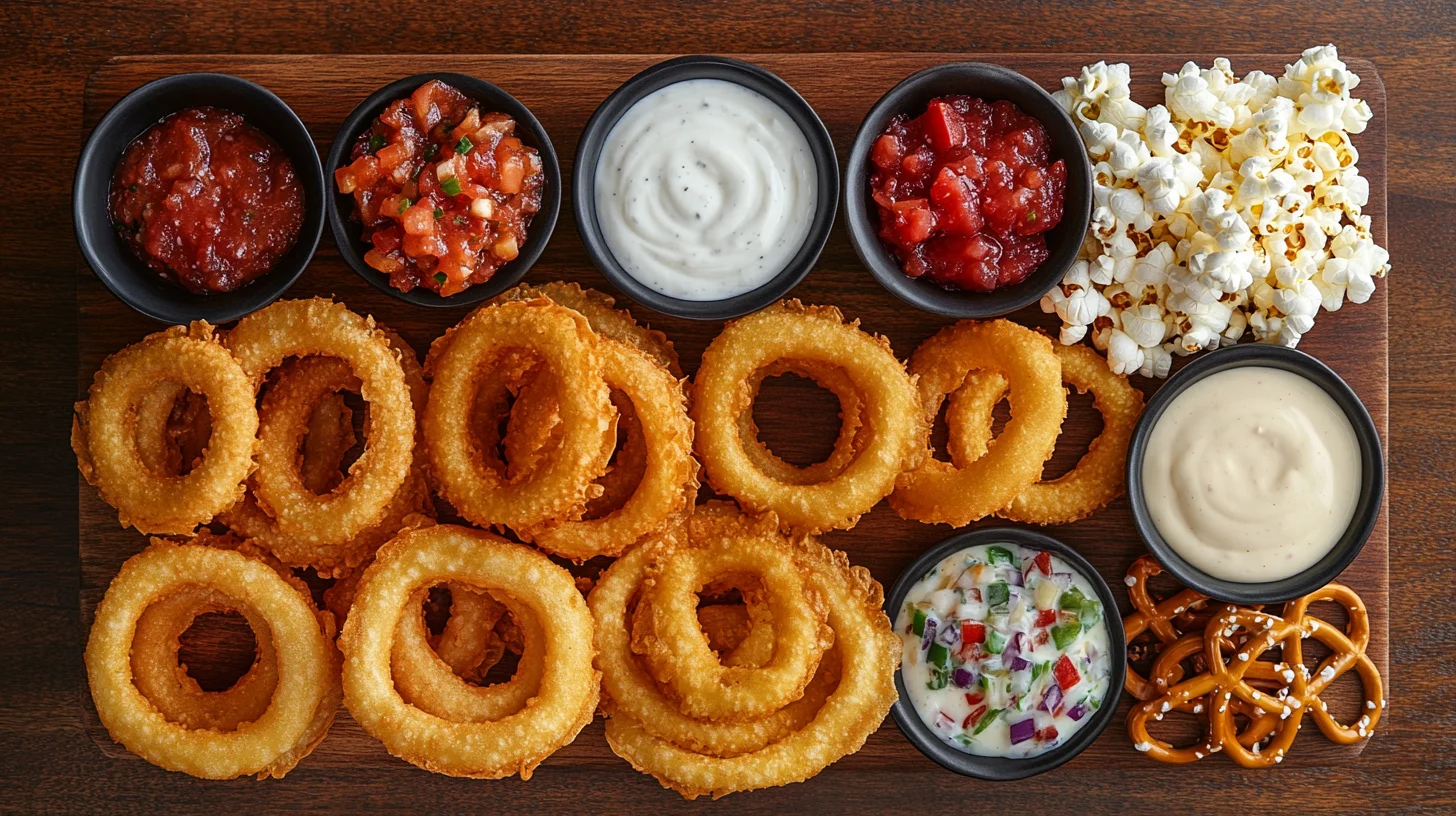Onion rings chips—crispy, savory, and oh-so-addictive—are quickly becoming one of the most beloved snacks across the globe. These crunchy delights offer the bold taste of fried onions, packed into a conveniently bite-sized chip that’s perfect for munching anytime, anywhere. But what makes onion rings chips so unique? Is it the flavor, the satisfying crunch, or the nostalgia they carry from classic onion rings?
In this ultimate guide, we’ll uncover everything there is to know about onion rings chips—from their humble origins to the intricate production process, nutritional facts, and creative ways to enjoy them. Whether you’re a snack enthusiast, a health-conscious shopper, or simply curious about trying something new, this article will walk you through all the essential facts and tasty secrets about this increasingly popular snack.
With crunchy textures, diverse flavors, and a growing variety of options for vegans and gluten-free eaters, onion rings chips have something for everyone. So grab a snack and let’s jump into the world of onion rings chips—you may just discover your next favorite treat!
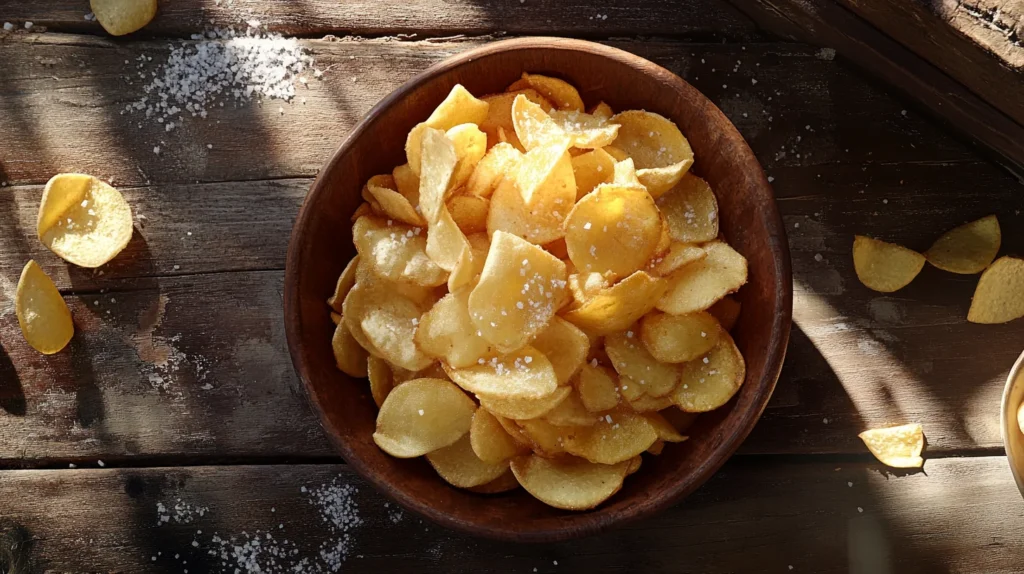
What Are Onion Rings Chips?
The Evolution from Classic Onion Rings
To understand onion rings chips, we must first take a look at their predecessor: the beloved onion ring. Traditionally made by coating onion slices in batter and deep-frying them to golden perfection, onion rings have long been a staple in diners, fast-food joints, and comfort food menus. They’re warm, savory, and satisfyingly greasy—perfect as a side dish or a stand-alone snack.
But times have changed. As the demand for convenient, shelf-stable snacks increased, manufacturers began looking for ways to replicate the flavor and essence of onion rings in a portable form. This led to the creation of onion rings chips—essentially crunchy, chip-like snacks infused with onion flavor and often shaped to mimic mini rings. They offer all the flavor of traditional onion rings without the mess or the need for a fryer.
Industrial Snack Revolution
The transformation of onion rings into chips was no accident—it was part of a broader industrial revolution in the snack food world. Companies started experimenting with extrusion technology and seasoning blends to create chips that captured iconic flavors, like cheese, bacon, or in this case, onion.
Thanks to modern food processing techniques, today’s onion rings chips come in countless variations. Some are air-puffed for a light crunch, while others are fried or baked to deliver that satisfying bite. The market is brimming with choices that cater to different dietary preferences, from spicy jalapeño onion rings chips to vegan and gluten-free options.
These innovations have allowed onion rings chips to gain popularity not only in the U.S. but worldwide. In countries like South Korea, Japan, and the U.K., you’ll find regional takes on the snack, often featuring unique spice blends and local seasonings that reflect each culture’s culinary identity.
How Onion Rings Chips Are Made
Main Ingredients
The irresistible taste of onion rings chips starts with a carefully selected list of ingredients. While recipes vary by brand and type, most onion rings chips share a few core components that deliver their signature flavor and crunch. These usually include:
- Dehydrated onion powder or onion extract for flavor
- Cornmeal, wheat flour, or potato starch as the base
- Vegetable oil (such as sunflower or palm oil) for frying or baking
- Salt, sugar, and spices to enhance the taste
- Yeast extract, monosodium glutamate (MSG), or natural flavors for umami
Some higher-end or health-focused brands may substitute MSG with sea salt, use non-GMO corn, or even opt for avocado oil instead of conventional vegetable oils. Gluten-free or vegan options may use alternative flours, such as rice or chickpea flour, to cater to dietary needs.
It’s also becoming common to see chips that are seasoned with real onion flakes, garlic powder, black pepper, and a touch of paprika for that extra zing. In short, while the ingredients might be simple, they’re carefully balanced to create a bold, mouth-watering flavor.
Production Process: From Onion to Crunch
The process of making onion rings chips is a perfect mix of food science and snack artistry. Let’s break it down:
1. Mixing the Base
First, the dry base ingredients like cornmeal or wheat flour are mixed with water and onion flavorings to form a dough. Depending on the texture desired, this mixture can be adjusted for density and moisture content.
2. Shaping the Chips
Next, the dough is fed into a machine that shapes it into thin rings or curls. Some manufacturers use extrusion, a method where dough is pushed through a specially shaped nozzle under high pressure, then quickly cut into uniform ring shapes.
3. Cooking: Baked or Fried
The shaped chips are then either fried in hot oil or baked in industrial ovens. Fried versions usually have a richer taste and a slightly greasier texture, while baked options offer a lighter, airier crunch with fewer calories.
4. Seasoning & Flavor Coating
After cooking, the chips go through a seasoning tunnel, where a dusting of flavor powder is evenly applied. This is where the magic happens—flavor scientists fine-tune the balance of onion, salt, and savory notes to create that unforgettable taste.
5. Cooling and Packaging
Finally, the chips are cooled and packaged into airtight bags to preserve freshness. Many bags include nitrogen flushing to prevent oxidation, keeping the chips crunchy for longer.
Modern production lines can churn out thousands of bags per hour, and thanks to automated quality checks, each chip maintains a consistent shape, size, and flavor profile.
This process shares some fun similarities with other comfort-focused slow-cooker dishes, like Cheesy Mozzarella Chicken that warms from the inside out.
Types of Onion Rings Chips
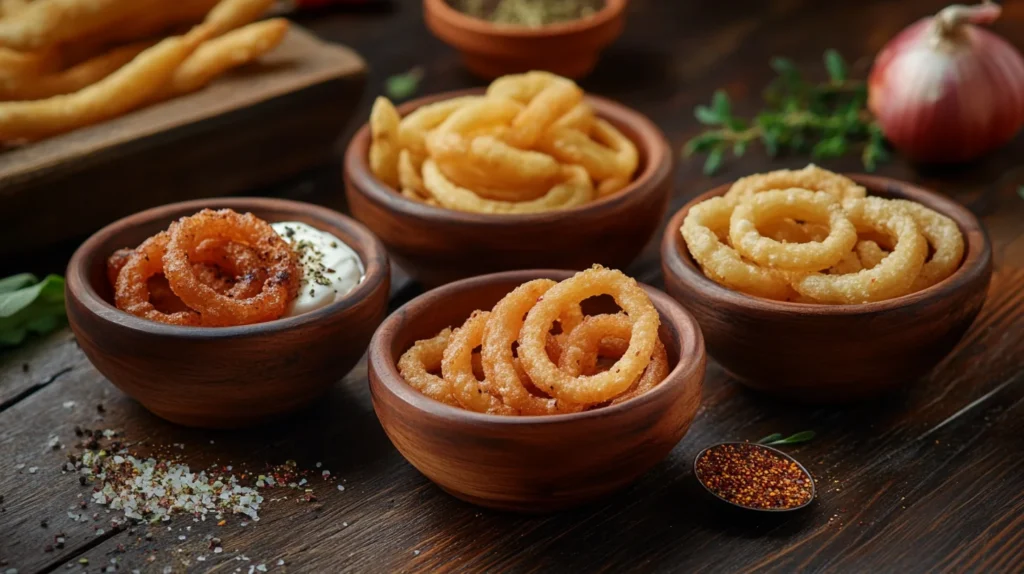
Not all onion rings chips are created equal. From traditional fried versions to healthy baked options, the snack aisle is packed with delicious choices. Let’s explore the most common varieties:
Baked vs. Fried Onion Chips
Fried onion rings chips are the traditional choice. They’re bold, crispy, and packed with flavor—but they come with more oil and higher calorie content. These are often chosen for their rich taste and indulgent mouthfeel.
Baked chips, on the other hand, are a great alternative for the health-conscious. With less oil and fewer calories, they offer a lighter texture that still delivers plenty of flavor. Some baked varieties even boast extra fiber or added vegetable ingredients for bonus nutritional value.
Flavored Onion Chips (BBQ, Sour Cream, Spicy)
Beyond the original onion flavor, manufacturers are getting creative with seasoning profiles. Some exciting and popular flavors include:
- BBQ Onion Chips: A smoky twist on the original, combining sweet and tangy barbecue flavor with onion.
- Sour Cream & Onion: A creamy, tangy classic that blends well with crispy onion rings.
- Spicy Jalapeño or Chili: For snackers who crave a bit of heat, spicy versions use chili powder, cayenne, or even wasabi for a bold kick.
- Cheese & Onion: A rich, savory combination that’s especially popular in the UK.
These variations not only cater to different taste preferences but also help brands stand out in a crowded market.
Think of these variations like flavor options in your favorite pies. (Speaking of flavor balance, this Peach-Blackberry Pie strikes the perfect sweet/tart note.)
Nutritional Value of Onion Rings Chips
Calorie Breakdown
One of the most common questions consumers have about Onion Rings Chips is: Are they healthy? To answer that, we need to break down the nutritional facts typically found on a standard serving (about 1 ounce or 28 grams) of onion rings chips. Depending on the brand and preparation method (baked vs. fried), a single serving may contain:
- Calories: 130–180 kcal
- Total Fat: 6–11 grams
- Saturated Fat: 0.5–3 grams
- Carbohydrates: 16–22 grams
- Sugar: 0–2 grams
- Protein: 1–3 grams
- Sodium: 150–300 mg
- Fiber: 0.5–2 grams
Fried chips tend to be higher in fat and calories, while baked varieties offer a lighter nutritional profile. Brands targeting health-conscious consumers may enrich their products with fiber or use less sodium to appeal to a wider audience.
Are Onion Rings Chips Healthy?
In moderation, onion rings chips can be part of a balanced diet. They’re a fun, flavorful snack—but it’s important not to rely on them for nutrition. Here’s a quick look at the pros and cons:
The Pros:
- Convenient and easy to store
- Long shelf life
- Portion control with pre-packaged bags
- Available in baked or low-fat versions
- Increasing number of vegan and gluten-free options
The Cons:
- Often high in sodium
- May contain artificial flavors or preservatives
- Low in essential nutrients like vitamins or minerals
- High-fat versions can contribute to weight gain if consumed excessively
Consumers looking for healthier snacks should check ingredient labels, choose baked over fried, and look for brands with cleaner, minimal ingredients.
Best Brands of Onion Rings Chips
Top Global Brands
The onion rings chips market is highly competitive, with several standout names that have earned loyal fans across the world. Some of the most recognized and beloved brands include:
- Funyuns® (by Frito-Lay): Arguably the most iconic onion rings chip brand in the U.S., Funyuns offer a crunchy, salty onion flavor with a distinctive hollow ring shape.
- Herr’s Onion Rings: Known for their strong flavor punch and satisfying crunch, Herr’s chips are a top choice in the Northeastern U.S.
- Walkers (UK): Famous for their cheese & onion flavor crisps, which offer a slightly different twist on onion rings chips.
- Tayto (Ireland): A local favorite with an authentic potato-and-onion flavor.
- Calbee (Japan): Known for their creative onion chip flavors like wasabi-onion or soy-sauce-onion combos.
These brands vary widely in terms of taste intensity, texture, and size—but all deliver the essential onion-flavored crunch that fans crave.
Affordable Local Alternatives
While international brands dominate the market, many local or store-brand onion rings chips offer great value for money and are often produced using regional ingredients or recipes. In grocery chains like Aldi, Trader Joe’s, or Lidl, you’ll find house-brand chips that mimic the taste of major brands at a fraction of the cost.
These alternatives are particularly appealing to price-sensitive consumers and families, offering comparable flavor without the premium price tag. Many smaller producers also highlight features like “no artificial flavors,” or “locally made” to attract health-conscious or eco-aware shoppers.
Onion Rings Chips vs Traditional Onion Rings
Taste Comparison
When it comes to taste, both onion rings chips and traditional onion rings offer that irresistible onion flavor—but in very different ways. Traditional onion rings deliver a fresh, juicy onion bite inside a hot, crunchy batter. The taste is bold, often enhanced by dips like ranch, ketchup, or spicy aioli.
Onion rings chips, on the other hand, rely on powdered onion flavor, combined with a crispy base (usually cornmeal or wheat flour). While they lack the juicy interior of the original, their consistency and seasoning intensity make them equally satisfying. The flavor tends to be saltier and more uniform across each bite.
It’s a case of fresh vs. processed, and both have their merits. One offers a restaurant-style indulgence; the other is a convenient snack-on-the-go.
Texture & Crunch Factor
Texture is another key difference. Traditional onion rings are soft inside and crispy outside, especially when freshly fried. Onion rings chips are entirely crunchy, offering a light, airy crisp or a dense, satisfying snap, depending on the brand and style.
This makes onion rings chips particularly attractive for those who crave crunch without grease. They also maintain their texture over time, unlike traditional rings, which can become soggy if not eaten right away.
Which Is Healthier?
While neither option is a superfood, baked onion rings chips tend to be the healthier choice. Traditional onion rings are deep-fried in oil, often adding significant amounts of saturated fat and calories. A small serving at a fast-food restaurant can easily exceed 400 calories, with more than 20 grams of fat.
In contrast, a typical serving of baked onion rings chips hovers around 130–150 calories, with less oil and fat. Many brands now offer reduced-sodium, low-fat, and clean-label options, making them a more manageable indulgence for health-conscious consumers.
How to Make Homemade Onion Rings Chips

Step-by-Step Recipe
Making onion rings chips at home is a fun and easy way to control what goes into your snack. Here’s a simple homemade recipe you can try:
Ingredients:
- 1 large sweet onion (thinly sliced)
- ½ cup cornmeal
- ½ cup of all-purpose flour, or substitute with rice flour for a gluten-free option
- 1 tsp baking powder
- 1 tsp garlic powder
- 1 tsp onion powder
- ½ tsp salt
- ½ cup cold sparkling water
- Vegetable oil for deep frying, or olive oil spray for baking
Instructions:
- Prep the onions: Slice onions into thin rings and separate them.
- Make the batter: Mix dry ingredients in a bowl. Slowly add sparkling water until you get a smooth, thick batter.
- Dip and coat: Dip each onion ring into the batter, shaking off excess.
- Fry or bake:
- For frying: Heat oil to 350°F (175°C) and fry until golden brown.
- For baking: Preheat oven to 400°F (200°C), place rings on a tray, spray with oil, and bake for 15–20 minutes, flipping once.
- Cool and season: Let them rest on paper towels. Dust with extra seasoning if desired.
These homemade onion rings chips are crispy, flavorful, and customizable. Add chili flakes, herbs, or cheese powder to create your own signature flavor.
Healthy Homemade Version
For a lighter version, try using an air fryer instead of traditional oil frying. You can also substitute the flour with almond flour, and use low-sodium seasonings for a heart-friendly alternative. Homemade options let you skip preservatives and artificial ingredients entirely.
Creative Ways to Eat Onion Rings Chips
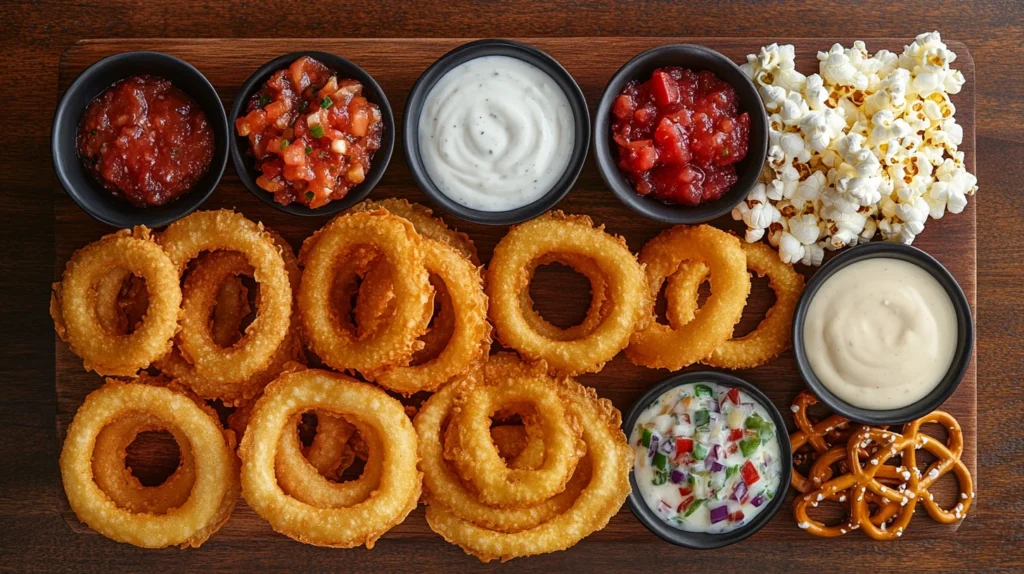
Pairings & Dips
Sure, onion rings chips are great on their own—but they’re even better when paired creatively. Here are some tasty suggestions:
- Dips: Ranch, sour cream & chive, spicy mayo, or guacamole
- Cheese sauces: Melted cheddar or nacho cheese
- Hot sauces: Sriracha, chipotle mayo, or buffalo sauce for extra heat
These pairings elevate the snacking experience and turn ordinary chips into a party-worthy treat.
Onion Chips in Recipes
Believe it or not, onion rings chips can also be used as an ingredient in creative dishes:
- Toppings for casseroles: Crush them up and sprinkle on top for a crispy finish
- Crunch in sandwiches: Add whole chips inside burgers or wraps
- Salad enhancer: Crumble as a crunchy garnish over salads
- Snack mix: Combine with pretzels, nuts, and popcorn for a homemade party mix
The possibilities are endless—think of them as a flavorful crouton with more punch!
Storage and Shelf Life
Best Storage Practices
Onion rings chips may come in a sealed bag, but how you store them after opening can make a big difference in maintaining freshness and flavor. Like most snack foods, they are sensitive to air, moisture, heat, and light, all of which can affect their crunch and taste.
Here’s how to store them properly:
- After opening, always reseal the bag tightly. Use a chip clip or transfer chips to an airtight container.
- Store in a cool, dry place—preferably a pantry or cupboard away from sunlight.
- Avoid placing them near heat sources like stoves or ovens, which can cause the chips to go stale faster.
- If you live in a humid climate, storing chips with a small food-safe silica packet (like the ones in seaweed packs) can help absorb excess moisture.
Following these simple practices can help keep your onion rings chips crispy and flavorful for days after opening.
Signs of Spoiled Chips
While most packaged onion rings chips come with a long shelf life (usually 6–12 months unopened), they can still go bad. Signs your chips are no longer good to eat include:
- Soggy or soft texture
- Rancid or off smell
- Stale taste
- Mold (rare but possible if exposed to moisture)
If any of these signs are present, it’s best to discard the chips. Spoiled snacks may not just taste bad—they could also pose health risks.
Buying Guide for Onion Rings Chips
What to Look for in a Quality Product
Not all onion rings chips are created equal, so here’s a checklist to help you choose the best bag:
- Flavor Profile: Look for chips that use real onion powder or extract. The more natural the flavoring, the better the taste.
- Crunch Level: Do you prefer airy and light, or thick and crunchy? Check reviews or opt for known textures (e.g., puffed vs. extruded).
- Ingredient List: The fewer artificial ingredients, the better. Avoid chips high in trans fats or MSG if you’re sensitive to those.
- Dietary Labels: Vegan, gluten-free, low-fat, and non-GMO options are now widely available.
- Packaging: Resealable bags are a bonus for freshness. Nitrogen-sealed bags help preserve crunch.
Online vs In-Store Buying Tips
In-Store Benefits:
- You can feel the bag to judge freshness (avoid overly crushed ones).
- Look for promotions, bundles, or trial-size versions.
- Local brands may only be available at physical retailers.
Online Advantages:
- Broader selection of flavors and specialty brands.
- Easier to compare nutrition info and customer reviews.
- Ideal for bulk buying or discovering international brands.
Online retailers like Amazon, Thrive Market, or specialty snack sites offer subscription boxes for onion snacks, allowing you to try new flavors regularly without leaving your home.
Market Trends & Popularity
Why Onion Rings Chips Are Trending
Onion rings chips are enjoying a surge in popularity thanks to several factors:
- Nostalgia marketing: The taste reminds people of childhood meals or fast-food favorites.
- Snack innovation: Brands are getting more creative with flavors, packaging, and textures.
- Healthier alternatives: With baked, low-fat, and vegan options, the snack now appeals to a wider audience.
- Social media influence: Trending TikTok and Instagram videos show unique ways to enjoy onion chips, creating viral demand.
Consumers are increasingly choosing snacks that are flavorful yet convenient, and onion rings chips hit both marks. They’re also ideal for impulse buying at gas stations and checkout lines, making them a staple of modern snacking culture.
Global Consumption Stats
According to the Snack Food Association, onion-flavored snacks (including onion rings chips) have seen a 12% increase in global sales over the past 3 years. The fastest-growing markets include:
- Asia-Pacific: Spicy and sweet onion flavors are extremely popular in Korea and Japan.
- North America: The U.S. remains a key market, especially for brands like Funyuns.
- Europe: Countries like the UK and Ireland favor cheese & onion combinations.
This growth shows no signs of slowing down, especially as brands continue to tailor flavors to regional tastes and dietary preferences.
Snack evolution is very real—just like the cultural twist in this authentic Paella recipe that celebrates regional tradition in every bite.
Frequently Asked Questions
What are onion ring chips made of?
Onion ring chips are typically made from a combination of cornmeal or wheat flour, onion powder, salt, vegetable oil, and various seasonings. Some recipes include additional flavor enhancers like monosodium glutamate (MSG), yeast extract, or natural flavors to replicate the savory depth of real onion rings.
Depending on the brand, other ingredients may include dehydrated onion flakes, sugar, and spices such as paprika, garlic powder, or black pepper. Health-conscious or specialty brands may use gluten-free flours like rice or chickpea flour, and they may bake rather than fry the chips to reduce fat content.
The dough is often extruded or shaped into mini rings, then cooked (either baked or fried), and coated with a flavoring blend that gives the chips their distinctive crunchy texture and bold onion flavor.
Are onion rings healthier than chips?
It depends on how both are prepared. Traditional onion rings, often deep-fried, tend to have higher fat content and more calories than many types of regular chips, especially baked ones. A typical serving of deep-fried onion rings from a restaurant can contain 350–500 calories and 20–25 grams of fat.
In comparison, many packaged chips, including onion rings chips, offer lower calorie options (around 130–180 per serving), especially if they are baked instead of fried. However, both snacks can be high in sodium and low in nutritional value, especially when consumed in large quantities.
If you’re comparing baked onion rings chips vs deep-fried traditional onion rings, the chips are usually the healthier choice. But when both options are fried, the difference is minimal in terms of health benefits. As always, moderation and portion control are key.
Are Funyuns the same as onion rings?
Are one of the most famous brands of onion rings chips—but they’re not the same as traditional onion rings. While they’re shaped like onion rings and flavored with onion powder and seasonings, Funyuns do not contain real onion slices.
Instead, Funyuns are made from cornmeal dough that’s shaped into rings using an extrusion process, then fried and seasoned to mimic the flavor of onion rings. They offer a crunchy, airy texture and a savory onion taste, but they don’t have the juicy interior or fresh onion slices that real onion rings have.
So, while Funyuns resemble onion rings and share a similar flavor profile, they’re technically a processed corn snack and a type of onion-flavored chip, not a direct substitute for the real thing.
How unhealthy are fried onion rings?
Fried onion rings can be quite unhealthy, especially when consumed regularly or in large portions. Here’s a breakdown of why:
High in Calories: One serving (typically around 6–8 rings) can range from 350 to 500 calories, depending on the size and how they’re fried.
High in Fat: Most of the calories come from fat—especially saturated fat and sometimes trans fats, which raise the risk of heart disease.
Low in Nutrients: Fried onion rings offer minimal fiber, vitamins, or essential minerals. They’re mostly empty calories.
High in Sodium: Fast-food versions are usually loaded with sodium, contributing to high blood pressure and water retention.
Carcinogenic Risks: When oils are repeatedly reused for frying, harmful compounds like acrylamides can form, which have been linked to cancer in some studies.
If you love onion rings, a healthier alternative would be to bake them at home, air-fry them, or opt for baked onion rings chips that use minimal oil and preservatives.
Conclusion
Onion rings chips have carved out their place in the snack world by combining the bold, savory flavor of classic onion rings with the crunchy convenience of a chip. Whether you’re reaching for a bag , trying a spicy jalapeño twist, or crafting your own batch at home, this snack offers something for everyone—from comfort food lovers to health-conscious snackers.
We’ve explored every crunchy detail: how they’re made, the difference between baked and fried versions, nutritional pros and cons, top brands, and creative ways to enjoy them. With the growing demand for vegan, gluten-free, and low-fat snacks, onion rings chips are constantly evolving to meet modern tastes and dietary needs.
If you’re looking for a snack that’s portable, flavorful, and fun, onion rings chips deserve a spot in your pantry. Whether you enjoy them straight from the bag, dipped in something creamy, or crushed on top of a casserole, they offer a uniquely satisfying way to enjoy the classic taste of onions—without ever shedding a tear.
So next time you’re in the snack aisle or browsing online for something new, consider giving onion rings chips a try. You just might find your new favorite crunch.
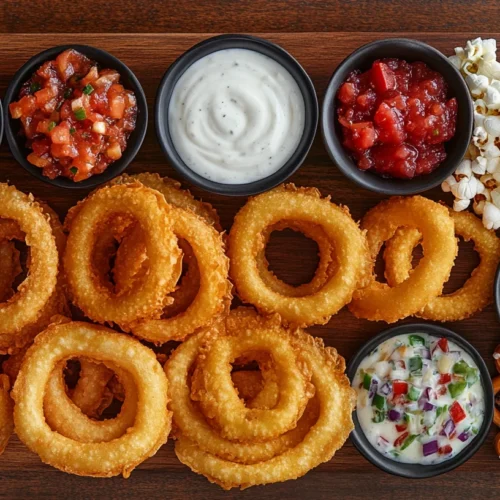
🧄 Onion Rings Chips – Homemade & Crispy
Equipment
- Baking tray or deep fryer
- Mixing bowls
- Whisk
- Knife & cutting board
- Parchment paper (if baking)
- Tongs or spatula
- Air fryer (optional)
Ingredients
- 1 large sweet onion thinly sliced into rings
- ½ cup cornmeal
- ½ cup all-purpose flour or rice flour for gluten-free
- 1 tsp onion powder
- 1 tsp garlic powder
- 1 tsp baking powder
- ½ tsp salt
- ½ tsp smoked paprika optional
- ½ cup sparkling water for extra crispiness
- Vegetable oil for frying or olive oil spray (for baking)
Instructions
- Preheat oven to 400°F (200°C) if baking, or heat oil to 350°F (175°C) if frying.
- Slice onion into thin rings and separate them.
- In a bowl, combine cornmeal, flour, baking powder, onion powder, garlic powder, salt, and paprika.
- Gradually whisk in sparkling water to form a thick but smooth batter.
- Dip each onion ring into the batter and coat evenly.
- For baking:
- Place battered rings on a parchment-lined baking tray.
- Spray lightly with olive oil.
- Bake for 15–20 minutes, flipping halfway.
- For frying:
- Carefully lower each ring into hot oil.
- Fry until golden brown, about 2–3 minutes per side.
- Remove and drain on paper towels.
- Let cool slightly before serving. Enjoy with your favorite dips!

